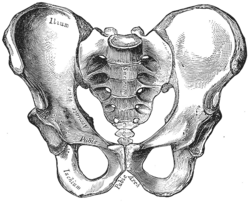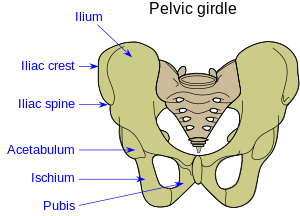
Back Bekken Afrikaans حوض (تشريح) Arabic Maxana AST РохокъотӀялъул ракьа AV Çanaq (anatomiya) Azerbaijani Таз Bulgarian শ্রোণিচক্র Bengali/Bangla Pelvis (korfadurezh) Breton Karlica BS Pelvis Catalan
| Pelvis | |
|---|---|
 Male type pelvis | |
 Female type pelvis | |
| Details | |
| Identifiers | |
| Latin | Pelvis |
| MeSH | D010388 |
| TA | A01.1.00.017 |
| Anatomical terms of bone | |


The pelvis (plural: pelves) is the part of the vertebrate body to which the legs attach. It has a very ancient history.[1] This article is only about the human pelvis.
Pelvis can mean the lower part of the trunk of the human body, between the abdomen and the thighs. Or it can mean just the bones in that region.
The pelvis is at the lower end of the spine. The pelvic skeleton is, at the back, the sacrum and the coccyx. At the front and to the left and right sides, there is a pair of hip bones. The legs are attached at the pelvis.
The pelvis protects the organs used for digesting and for reproduction. It has many muscles attached. The muscles are mostly to do with keeping the body upright and with walking and running. Muscles attach to the bones with tendons. The bones of the pelvis are attached to each other by and to the sacrum by ligaments.
The pelvis bones are symmetrical, the same on both sides.
1. The hip bone made of:
2. The sacrum
3. The coccyx
- ↑ Clack, Jennifer A. 2012. Gaining ground: the origin and evolution of tetrapods. 2nd ed, Indiana University Press, pp34, 51/3, 172/3, 432/5.